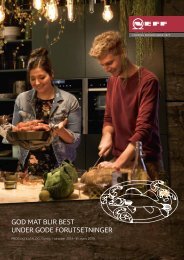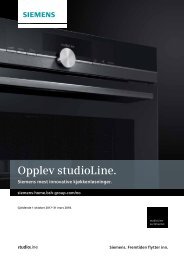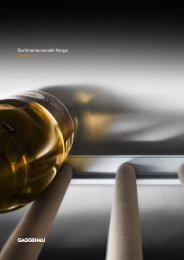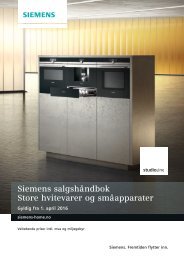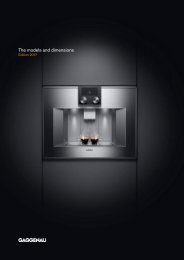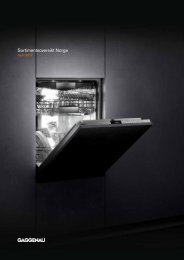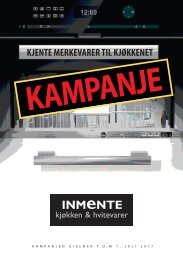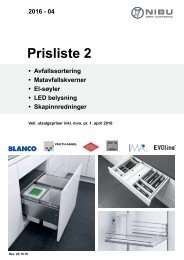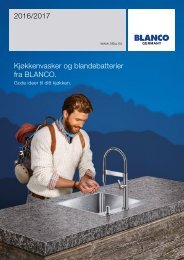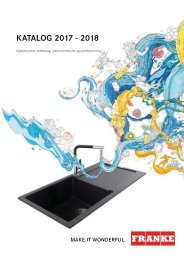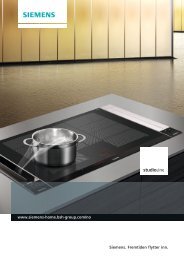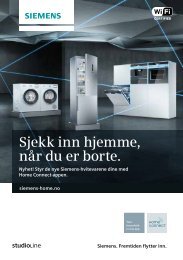Gaggenau - The brand
Create successful ePaper yourself
Turn your PDF publications into a flip-book with our unique Google optimized e-Paper software.
After 333 years of crafting metal, we have created<br />
something that transcends <strong>brand</strong>: it is a culture.
In 1683, from the depths of the Black Forest, new<br />
sounds are heard; the roar of flame, the pounding of<br />
metal. <strong>The</strong> age of the industrial craftsman arrives with<br />
the shuddering strike of a hammer and the legend<br />
that is German Engineering is born.
years in the making<br />
Our story springs to life on the edge of the Black Forest in 1683. This was an area of<br />
poor farmers spending generation after generation barely scratching a living in the<br />
shadow of the foreboding prehistoric woodland. <strong>The</strong> aristocratic ruler of the Baden<br />
region was Margrave Ludwig Wilhelm von Baden, hero of the Imperial Army, reliever<br />
of besieged Vienna and a man who got things done. Seeing a land rich in iron ore and<br />
timber, he established a smelting plant in Rotenfels and a hammer mill and nail forge<br />
in <strong>Gaggenau</strong> in 1683. An inspired idea that unfortunately was not an immediate<br />
business success.
1683<br />
Margrave Ludwig Wilhelm von<br />
Baden founded <strong>Gaggenau</strong><br />
Your first 200 years are always difficult<br />
By the mid to late 1700s the <strong>Gaggenau</strong> nail-making business had begun to find its<br />
feet, just as Europe began to experience one of its more revolutionary eras. <strong>The</strong><br />
foundry passed from owner to owner, its fortunes rising and falling with that of the<br />
area. <strong>The</strong> rapacious appetite of the smelting furnace was more consistent, consuming<br />
acres of woodland and the wealth of several owners.<br />
Manufacturing, especially in the midst of wars and religious upheaval, is challenging.<br />
In the main, this progressive enterprise survived, which is more than can be said of<br />
many other progressive individuals at the time. <strong>The</strong> Age of Agitation was brought into<br />
sharp focus in 1850 when the positive process of melting cannon balls down into<br />
something more peaceful, backfired. <strong>The</strong> cannon balls were actually live grenades<br />
and very nearly destroyed the smelting furnace.<br />
But, yet again, <strong>Gaggenau</strong> survived.
1873<br />
Michael Flürscheim<br />
purchases <strong>Gaggenau</strong><br />
1880<br />
<strong>The</strong>odor Bergmann,<br />
stove maker, joins<br />
<strong>Gaggenau</strong> metalworks progressed to making farm machinery. Decades passed and<br />
the place and its people began to make a name for themselves. Its ironworks grew in<br />
number and scale, necessitating the building of a dedicated railway to carry the heavy<br />
products to market. <strong>The</strong> days of making nails were over. New products for a new<br />
industrial class were being mass-produced and the foundation of the German<br />
Engineering legend was being laid.<br />
<strong>The</strong> ‘Eisenwerke <strong>Gaggenau</strong> Flürscheim und Bergmann’, as it was now called, started<br />
to market itself as ‘<strong>The</strong> establishment for novelties’. It had graduated from farm<br />
machinery and entered the new century on bicycles, with pistols, rifles and enamel<br />
advertising signs, key skills and products that were about to feature heavily in its<br />
future. Michael Flürscheim and <strong>The</strong>odor Bergmann brought modern industrial<br />
processes and innovative products to <strong>Gaggenau</strong> while improving working practices<br />
and workers’ conditions.
1887<br />
Enamel advertising signs<br />
produced for Stollwerck,<br />
Maggi, Odol and Tobler<br />
1891<br />
<strong>The</strong> birth of the<br />
Badenia Bicycle<br />
1908<br />
<strong>The</strong> 250,000 th Badenia<br />
Bicycle is sold
Ballooning to over a thousand employees and struggling to produce up to 200<br />
product lines, this was an enormous, sprawling enterprise. <strong>The</strong>y produced a quarter<br />
of a million well-made, coveted Badenia Bicycles between 1880 and 1908. <strong>The</strong> two<br />
leading lights, Flürscheim and Bergmann, had both left the company by the turn of<br />
the century, but the success of the bicycles and advertising panels had taught the<br />
collective of workers and managers the importance of ergonomics, build quality and<br />
distinctive design.<br />
<strong>The</strong> runaway success of just two of the 200 products may well have also introduced<br />
a little focus into an otherwise extremely diverse business. <strong>The</strong> enamelling skills<br />
learned for the advertising signage business were to give <strong>Gaggenau</strong> the edge<br />
throughout the 20 th century as they shifted production from enamel for advertising to<br />
enamel for ovens.
1931<br />
<strong>The</strong> introduction of<br />
electric ovens<br />
1948<br />
Modern, economic, coal,<br />
gas and electric, ‘Favorit’<br />
and ‘Futura’ ovens<br />
<strong>The</strong> 20 th century, our third<br />
<strong>Gaggenau</strong> was soon forced to contend with the Great War and then the Great<br />
Depression, two catastrophic events that saw many great German companies come<br />
to an abrupt end. And its story almost ended there. <strong>Gaggenau</strong> was bankrupt when<br />
Dr. Otto von Blanquet quietly purchased the entire company in 1931.<br />
With a new focus on coal, gas and, innovatively, electric stoves, the company grew<br />
before once more being consumed by a World War. With much of the country’s<br />
industry given over to the war effort, <strong>Gaggenau</strong> was no exception. <strong>The</strong> Allied bombing<br />
campaign rolled over <strong>Gaggenau</strong> in 1944, destroying virtually everything. For the<br />
second time, the company was being asked to emerge from the ashes.<br />
After the war Dr. von Blanquet continued making ovens, but of a new kind. <strong>The</strong> refined<br />
design required less coal and gas to run, giving <strong>Gaggenau</strong> a reputation as the<br />
economical choice. <strong>The</strong> promotion of electric ovens also proved popular, the Favorit<br />
and Futura electric models, as well as heater and ventilation systems, put <strong>Gaggenau</strong><br />
in many new kitchens across reconstructed Europe.
1956<br />
Georg von Blanquet<br />
takes over<br />
1956<br />
<strong>The</strong> first built-in<br />
eye-level oven<br />
1972<br />
<strong>The</strong> first modular<br />
Vario system
<strong>The</strong> business was doing well and the <strong>brand</strong> was synonymous with quality and<br />
innovation when Dr. von Blanquet handed over to his son Georg in 1956.<br />
Georg von Blanquet was a chef and, under his reign, <strong>Gaggenau</strong> produced what<br />
Georg wanted to cook with. Thankfully, Georg tapped into a burgeoning culinary<br />
culture and a reappraisal of the kitchen for the brave new postwar world. His ideas led<br />
the company and the industry into startling, imaginative directions. He paved the way<br />
for the fitted kitchen revolution, and in 1956 the first built-in, eye-level oven, separate<br />
cooktop and ventilation appliances were all brought to market, by us.<br />
His appetite for change was matched only by his demand for quality. New functions<br />
had to prove useful to chefs, be sturdy enough for the working kitchen and look<br />
beautiful. Being a cook with an engineering works at his disposal, he turned the<br />
challenges facing chefs into opportunities for engineers. What he refused to do, like<br />
any good cook, was offer up something before it was ready.
1976<br />
First downdraft ventilation
1978<br />
<strong>The</strong> Grill Mobile makes<br />
its first appearance<br />
1982<br />
First flat kitchen hood<br />
is created<br />
Some things you perfect and there is very little room for improvement. We aim to do<br />
this with every product we make. We do not hurry to launch innovations, instead we<br />
discover a need, perfect a solution, exhaustively test it and only then do we offer it to<br />
our customers. So, rather than add an egg timer to the control panel, we will have a<br />
team of visionary designers and open-minded technicians talking to a few, carefully<br />
chosen, demanding chefs about how best to make a more progressive oven. It might<br />
be that we introduce a new concept into the private kitchen. Or, we tweak a setting,<br />
introduce a sous-vide function or a vacuuming drawer. Or we all agree that everything<br />
is the best that it can be and therefore we will change nothing.<br />
We do not follow cooking trends, instead we create a movement, lead an evolution<br />
and define the future. If that sounds a little grandiose, that is because it is.<br />
Rather than add an egg timer to the control panel,<br />
we will have a team of visionary designers and<br />
open-minded technicians talking to a few, carefully<br />
chosen, demanding chefs about how best to make a<br />
more progressive oven.<br />
Christopher Lupp, Product marketing
…finished by hand, this is the only<br />
way to put soul into the products.<br />
Sven Baacke, Design
1986<br />
<strong>Gaggenau</strong> introduces<br />
the 90 cm EB 300 oven<br />
1990<br />
IK 300, the iconic double<br />
door fridge freezer, filled<br />
with innovations
Our future began more than three centuries ago<br />
<strong>The</strong> EB 388 was designed to protrude. We were<br />
unwilling to compromise on the internal capacity, so<br />
we eked a little more out of the space.<br />
Janina Fey, Design<br />
<strong>The</strong>re is not a separate past, present and future. <strong>The</strong> same process that saw a forge<br />
emerge from a forest also made 250,000 phenomenally popular bicycles and brought<br />
the first self-cleaning combi-steam oven to the market in 2015. <strong>The</strong>y are different<br />
expressions of the same philosophy. We have always imagined what could be, then<br />
designed, built and tested it.<br />
In the 50s, we were instrumental in creating the fitted kitchen that you go home to<br />
today. In 1972, our first modular Vario system became the next kitchen evolution. We<br />
developed the first downdraft ventilation in 1976, the first flat kitchen hood in 1982,<br />
championed the large 90 cm wide, 87 litre capacity EB 300 oven in 1986 and in 1999<br />
we introduced the combi-steam oven into the private kitchen and then gave it the<br />
ability to wash itself using its own water supply. We have become known as the<br />
company that creates the forks in the road of history, new directions – the future.
1999<br />
<strong>Gaggenau</strong> introduces<br />
the steam oven<br />
And the combi-steam oven<br />
First use of the Coanda<br />
effect in a ventilation hood
New gets old fast<br />
We never invent for the sake of it. We conceive something new only if it makes sense,<br />
creating the best that something can be for the chef at home. This guiding principle<br />
determines that inventions are perfected before we bring them to market, that<br />
improvements will be made when they can be achieved and the aesthetic is never<br />
compromised. In between these moments of true innovation, we simply maintain our<br />
formidably high standards.<br />
<strong>The</strong>re is always some new adjustment to the production line; the hard truth is that it is<br />
not always noteworthy. We save our external excitement for the big things. That can be<br />
the first steam oven or a unique self-cleaning system. <strong>The</strong> culinarian’s experience<br />
guides all; we provide the means for them to achieve what they previously could not.<br />
<strong>The</strong>re is no end to the possibilities. We have several excited designers and chefs<br />
waiting impatiently for the materials and technology to catch up with their imaginations.
2003<br />
<strong>The</strong> IK360 wine cabinet,<br />
with three precisely<br />
controlled climate zones
As inventive as we are, we do not allow technological possibilities to overrule our<br />
design principles. Our TFT touch displays offer millions of colours – our designers<br />
chose two. Not only does this look better, it allows you to know what information you<br />
are in the act of changing and what information you are simply viewing. Those are the<br />
only two distinctions the display needs to make to help the private chef quickly<br />
understand and continue cooking.<br />
Innovations and appearance need to strike a chord with the user. <strong>The</strong>y have to appeal<br />
to something more than logic and infuse a product with something greater than a<br />
collection of features. Were we to get emotional about it, we would say a product<br />
needs to have something akin to a soul.
Our values, unchanged since 1683, are<br />
an ongoing quest for authenticity and<br />
uncompromising quality. <strong>The</strong>y are part<br />
of our DNA today and will be for the next<br />
333 years.<br />
Sven Schnee, Brand management
2007<br />
<strong>The</strong> Vario cooling 400<br />
series, a fully integrated,<br />
modular system, launches<br />
<strong>The</strong> ovens 200 series also<br />
launches. A busy year<br />
It is about the culinary artist, not the oven<br />
A <strong>Gaggenau</strong> kitchen exists only to offer the best cooking experience. <strong>The</strong> cook can<br />
trust that deep thought and restless nights have gone into each function and every<br />
nuance. Nothing is there just because it is possible, it is there because it improves the<br />
complete experience.<br />
An important part of that experience is visual. Design has been integrated into our<br />
processes since we made beautiful bicycles in the 1890s – it is no afterthought.<br />
<strong>The</strong>re is a designer at every meeting, debating with the engineer whose role it is to<br />
make the impossible. Our 3 mm stainless steel frame for our Vario cooktops 400<br />
series is an engineering headache. It is tremendously difficult to achieve and requires<br />
extensive hand machining by seriously skilled individuals, but the end result is worth it.
2011<br />
<strong>The</strong> pioneering full surface<br />
induction cooktop with<br />
intuitive interface launches<br />
Integrating design into the process from the very inception might lead to fads in other<br />
circumstances, but this is something we are averse to in the extreme. Our designers<br />
go the other way: they create timeless classics. Our flat kitchen hood AF 250 is<br />
consistently judged as the best designed in blind tests against other hoods on the<br />
market. Its appearance has not changed in 35 years: it has not had to. Our selfcleaning<br />
system for the combi-steam oven 400 series is a world first. By simply<br />
inserting a cleaning cartridge into the housing within the oven’s ceiling, you can sit<br />
back and let the water do the work.<br />
What does that have to do with cooking? A chef at home creates, they take risks,<br />
they try new and exciting combinations of outlandish ingredients. Sometimes it works,<br />
sometimes it does not, but creating a masterpiece can be a messy process. We want<br />
to free the chef from the oppressive, uncreative activity of cleaning. It is no job for a<br />
talented genius, it is a job for the oven and another enhanced experience for the chef.
2012<br />
Laser cutting and welding introduced<br />
for the precision finish of the Vario<br />
cooktops 400 series frames<br />
At <strong>Gaggenau</strong>, designers acknowledge and filter<br />
everything around them but are not distracted from the<br />
main goal.<br />
Sven Baacke, Design<br />
Every piece that leaves our workshop is burdened with a 333-year reputation. It<br />
cannot fail, it cannot even disappoint; it must excel. We are immensely protective of<br />
that reputation; it is a rare, precious and fragile thing. It can be lost in a moment of<br />
carelessness or greed, but it is also strong, built in metal by generations of our<br />
forebears. It is something each of us at <strong>Gaggenau</strong> feel obliged to live up to every day.<br />
A company cannot really care, but the individuals within it can, should and ours do.
<strong>The</strong>re are thousands of elements<br />
and processes that we simply do not<br />
outsource. Everything is tested before<br />
it leaves the factory, often at each stage<br />
of its build.<br />
Stefan Köhl, Product management
2012<br />
Establishment of our cleanroom<br />
for the development<br />
of a new user interface<br />
Difficult is our ideal<br />
When our control knob was being developed, the concept of control was re-imagined.<br />
We invented, designed and prototyped, over and over. So that you delight in the twist<br />
of a solid stainless steel knob and it turns in precise, reassuring increments. It feels<br />
right, which does not happen by accident.<br />
Our own touchscreen displays are assembled within our airtight, dust-free cleanroom.<br />
It is the only way to ensure the controls, where the machine meets the chef, are<br />
as exceptional as the rest of the piece. An oven’s enamel is made to our own recipe,<br />
and has been for over a hundred years. We hand-chisel our name into our baking<br />
stones. <strong>The</strong> stainless steel fronts to the doors to our fridge-freezers take a full two<br />
hours and forty three minutes to hand-weld and hand-finish. Even the wiring in each of<br />
our ovens is hand-finished – each individual wire.<br />
One of the benefits of so much hand assembly is that rare thing: the look-over. Before<br />
any of our people put an item in the completed area, they stop and visually check not<br />
only what they have done, but the item as a whole, with a trained, experienced,<br />
unforgiving eye. Visit our factory and see it happen; it is a simple, obvious<br />
consequence of people taking pride in their work. To produce authentic, extraordinary<br />
pieces, you must be uncompromising. And a little difficult.
2013<br />
<strong>The</strong> ovens 400 and<br />
200 series arrive<br />
Knowing when to stop<br />
We take our perfectly finished stainless steel for our Vario cooktops 200 series and<br />
shot blast it with ceramic beads. This added process achieves a delightful silky lustre<br />
that draws the eye and invites the fingers to touch while hiding the resulting<br />
fingerprints. It also reduces the visual effect of scratches because, as beautiful as<br />
these structures are, they are working pieces and they will come into hurried contact<br />
with other, unforgiving metal objects. We have prepared our surfaces for this<br />
inevitability, ensuring that they age well, without showing their years. We know when<br />
to stop; when you can no longer improve.
<strong>The</strong> only way to keep one side of the oven<br />
door cool while the other is at 485˚C is<br />
through insulation. <strong>The</strong> oven 400 series<br />
door is made up of four layers of glass.<br />
Tania Goetzmann, Product management
2014<br />
New LED light pillars in the<br />
Vario cooling 400 series contrast<br />
with handmade oven wiring<br />
Of the 840 processes required to make one<br />
of our cooling appliances, 813 are done by hand.<br />
Equally, we pioneered computerised laser welding.<br />
We are wedded to quality rather than process.<br />
Ramona Haberkamm, Product management<br />
<strong>The</strong> reason for <strong>Gaggenau</strong>’s fastidious attention to detail is, to quote a somewhat<br />
overused expression: failure is not an option. Hand-assembly of our own wiring is<br />
completed on wooden templates. We then test the electronics of every one of our<br />
pieces before they leave the factory – needless to say, this is not the industry<br />
standard, but then neither are we. <strong>The</strong>se intricate, handcrafted processes are<br />
conducted in the same building that houses the futuristic clean room, the same<br />
factory that makes the steel, creates the enamel and produces the finished product.
2014<br />
<strong>The</strong> ventilation 400 series:<br />
island and wall-mounted<br />
hoods complete the range<br />
Automation and efficiency are also not things we shy away from and our pieces<br />
are a testimony to these aspirations. Our baking sheets are created by a machine<br />
generating 400 tonnes of pressure, rather than a burly blacksmith with a hammer, but<br />
we insist that someone, burly or otherwise, checks the sheets going in and out of this<br />
machine. And that is a baking sheet, so for the Vario cooktops 400 series, a complex<br />
interconnecting precision instrument, we hand assemble the final steps. Because<br />
nothing compares to the skilled hands and focused eyes of a craftsperson.
2015<br />
Introduction of a unique<br />
automatic cleaning system<br />
for the combi-steam oven<br />
Quality control freak<br />
To not test the performance of any individual piece would haunt us. Not only do we<br />
use the finest materials in our pieces, we are also happy to lavish time on them. An<br />
oven is fastidiously tested through Pyrolytic cleaning, because of the high<br />
temperatures involved. While this is time, energy and labour intensive, it is the only<br />
way to ensure the customer’s oven works. So we invest three extra hours into each of<br />
our pyrolytic ovens, putting them through a sustained 485 °C clean before they go<br />
anywhere. We take as long to test one of our less complex fridges as we do to build it.<br />
And where others do check a critical element of an appliance, we will test it twice.<br />
This is not us trying to be different: this is important, therefore we need to qualitycontrol<br />
the quality-control.
We do things a certain way, not to impress<br />
or differentiate, but because that is what is<br />
required to achieve perfection.<br />
Sven Baacke, Design
2016<br />
Launch of the<br />
vacuuming drawer<br />
People power<br />
We are parents of the <strong>Gaggenau</strong> <strong>brand</strong>. We feel<br />
an emotional connection and responsibility, without<br />
knowing what we will get back. It has its own<br />
energy and life: we are simply looking after it for<br />
the next generation.<br />
Sven Schnee, Brand management<br />
To create extraordinary products, you need extraordinary people. That, and an<br />
environment fuelled by trust and loyalty where everyone has a voice and shares a<br />
singular vision.<br />
At <strong>Gaggenau</strong>, we see everyone as an entrepreneur, always striving to inspire, and<br />
passionate about the result. When the final touches were made to the EB 333, the<br />
updated version of the EB 388 icon, everyone on the production line crowded round<br />
to see the finished product. <strong>The</strong>re is a little of all of them in it.<br />
We are equally emotional and selective about our partners. We choose to work with a<br />
professional chef because they inspire us, not because they are famous in a<br />
consumer world. Ego does not make the grade – we want shared attitudes,<br />
inspirations, passions and an authentic contribution. Our chefs help us develop our<br />
products and shape our journey so we can help them evolve and develop their cuisine.<br />
And you yours.
2016<br />
<strong>The</strong> EB 333 icon is<br />
re-imagined, updated<br />
and revealed<br />
Back to the future<br />
Change is additionally important for a <strong>brand</strong>. Of course we are aware of<br />
what is happening elsewhere and we adapt as and when required. But<br />
rather than follow others or seek to lead them, we simply strive to produce<br />
the finest to befit the experience.<br />
Sometimes, to move forward, it is good to look back. <strong>The</strong> iconic 90 cm-wide<br />
oven was introduced 30 years ago, but is still going strong – uncompromising,<br />
tested, proven. We spent three years creating the original and another 30<br />
perfecting it into something new. This remodelled work of art represents<br />
the culmination of our finest principles, skills and ethos, so we have<br />
christened it the EB 333 in recognition of our three-and-a-third centuries<br />
of working in metal. It stands alone in the culinary world as the generous,<br />
coveted classic and private choice of the professional chef for three<br />
decades. We might have tweaked, enhanced and refreshed the design,<br />
but we remain true to the soul.<br />
A labour of love, predominantly hand-crafted,<br />
barely 2,500 of these design icons will be<br />
created in any given year. <strong>The</strong> EB 333 is more<br />
than an oven; it is a huge statement of intent, a<br />
promise to create culinary masterpieces.<br />
Yves Lebrun, Product development
Create a <strong>brand</strong> and it can live for years<br />
or decades. Create a culture and it can<br />
live for centuries. We are proud of the<br />
<strong>Gaggenau</strong> culture.<br />
Matthias Ginthum, Board member
What is a kitchen?<br />
To us, the kitchen is not a static room full of machines, it is a mindset. Family, warmth,<br />
nourishment, belonging, status… it means different things to different people. It can<br />
be a playground, a refuge, a statement. So we do not sell cooking equipment – we<br />
provide an environment in which you can create the culinary culture you want, so you<br />
can be the cook you aspire to be.<br />
Consider the microwave. Loved and hated in equal measure, we see it as part of a<br />
private chef’s armoury. Our combi-microwave oven is a nod to the professional kitchen<br />
where it is all about convenience and multitasking. We do not mind if you use yours to<br />
roast a spatchcocked chicken or bring your pre-made entrée up to temperature. We<br />
just care that your roast or amuse-bouche is the best it can be.
Awaken the senses<br />
<strong>The</strong> <strong>Gaggenau</strong> difference continues beyond the product. <strong>The</strong> importance of the<br />
tactile experience cannot be overstated. <strong>The</strong> quality of components, build and design<br />
is best understood when you can sense it for yourself.<br />
Any film can have endless interpretations because we view it through the prism of our<br />
own experience. At one of our showrooms or live events, you can see, touch and<br />
interact with our products, but you will imagine them within your own vision of the<br />
perfect kitchen. All we can do is feed that imagination. Specifications and proof of<br />
excellence are there if you want them, but ideas are what we promote. We will seduce<br />
your senses with brushed steel surfaces that beg to be touched, silent door<br />
mechanisms you will strain to hear, candles fused with heritage scents of fire and<br />
forest… Our spaces are places you can dream and plan.
Our magazine ‘new spaces’, touches on all the topics that inform our culinary<br />
culture; not just cuisine, but also architecture, art, design. A version of these<br />
musings is hosted on our website, entitled ‘Essays’. Instagram and Pinterest each<br />
have an official <strong>Gaggenau</strong> destination for the interested to peruse – and we do aim<br />
to be interesting.<br />
We do not want to prescribe an ideal culinary culture,<br />
we want to help you realise yours.<br />
Stefan Hoesle, Communication
So where next?<br />
We are not a large factory churning out hundreds of<br />
thousands of products. We do fewer, to a higher quality.<br />
And quality takes time.<br />
Philipp Kipper, Manufacturing<br />
When the first flames roared in that Black Forest forge in 1683, the workers may not<br />
have foreseen today’s ground-breaking appliances. But they believed in excellence<br />
and innovation just as we do today. And we know we will still be using those same<br />
values to create uncompromising solutions for the kitchen of the future.<br />
Our lengthy history makes it easy to take a long-term perspective. We are not a large<br />
factory churning out hundreds of thousands of products. We do fewer, to a higher<br />
quality. And quality takes time. That might be five or ten years from a concept to build,<br />
but in our grand scheme of things, that is no time at all.
<strong>The</strong> future here and now<br />
How we prepare and consume food changes constantly. Whether we are time-poor<br />
and craving convenience or concerned about the environment, we want beautiful<br />
solutions quickly. <strong>Gaggenau</strong> stays one step ahead. For example, the entire surface of<br />
the CX 480 induction cooktop can be used as one large cooking zone. It automatically<br />
identifies and heats each pot and pan where it stands. Our dishwashers use Zeolite<br />
technology to wash and dry a full load of dishes faster, reducing environmental<br />
impact. And because we use the best materials, the lifespan of our products is greatly<br />
extended, reducing their carbon footprint even further. In short, we are always working<br />
on the next big thing so it is ready before you know you even need it.
<strong>The</strong> next big thing<br />
No one knows what the next 20, 50 or 333 years will bring, but we certainly know that<br />
aspirations will change. What will cuisine look like? How will tastes develop? Will we<br />
want bigger ovens? Or smaller ones? Will we even need ovens to produce the perfect<br />
meal? In fact, what will luxury look and feel like?<br />
Perhaps in the future there will be no physical kitchen at all. Perhaps ownership of<br />
beautiful pieces, though pleasing, will be less precious than sharing a mindset – the<br />
<strong>Gaggenau</strong> mindset – that will have a strong influence on the rest of your life. What we<br />
do know is that if the kitchen is the heart of the home, then <strong>Gaggenau</strong> is its soul.
We have told you our story so far, an amazing tale spanning<br />
three-and-a-third centuries. But that is only the beginning<br />
– a mere 333 years in the making…
www.gaggenau.com BSH Hausgeräte GmbH, P.O. Box 830101, 81701 Munich, Germany<br />
Q9G1LA0126



